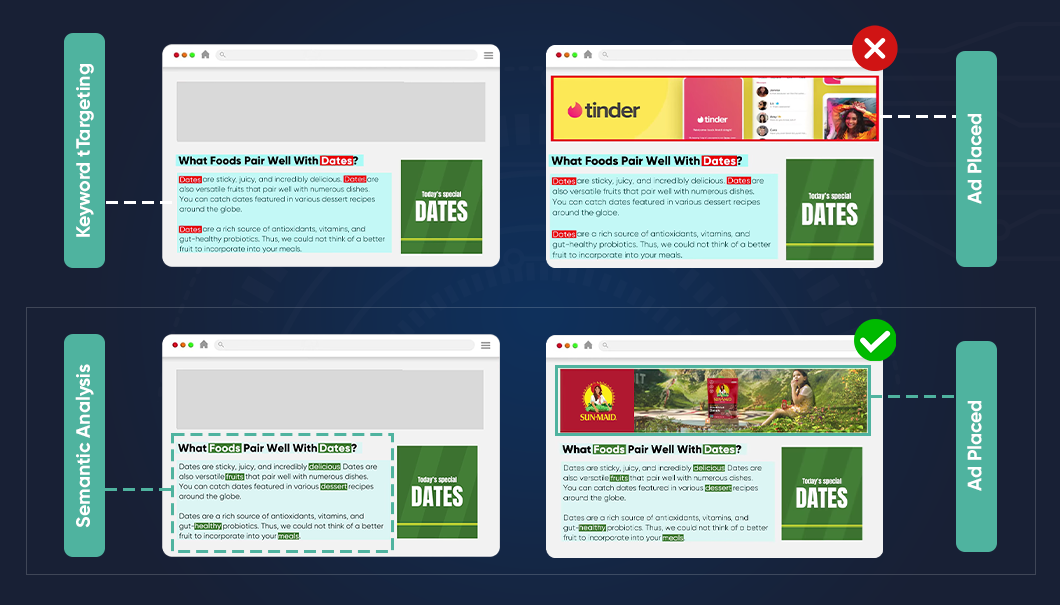Finding Balance: Contextual Advertising and User Privacy in Open Web | 07 Jun, 2023

Advertising is a crucial element for any brand as it drives its revenue by pursuing customers from the beginning of the funnel, that is, brand awareness to conversion. Along with customer acquisition, it also generates strong brand awareness and builds a brand image.
The advertising landscape today is facing the issue of users’ online privacy which has become an alarming concern for brands. It is moving towards privacy-first advertising.
“66% of consumers have expressed discomfort with businesses and brands tracking their browsing history to deliver personalized ads.”
This statistic highlights a growing unease among internet users regarding the use of their data for targeted advertising purposes. As a result, businesses and advertisers are increasingly seeking alternative strategies that respect user privacy while still delivering relevant and engaging advertisements. In this context, finding a balance between personalized advertising and privacy has become crucial for brands to maintain consumer trust and loyalty.
Mirrors is a contextual advertising solution for the open web by Silverpush which is helping brands tap into the audience while abiding by the privacy guidelines set by General Data Protection Regulation (GDPR) and California Consumer Privacy Act (CCPA).
How can Mirrors be a Game Changer in a Privacy-First Environment?
More and more internet users worldwide are expressing increased concern about their online privacy, with 67% of the population is stating that they are more concerned than ever. A study found that 81% of people prefer to see ads that are relevant to their browsing experience, and 65% of consumers have a more positive opinion of brands that offer contextually relevant ads.
And, with this, brands need to be more concerned about their advertising strategies to navigate this shift in consumer mindset.

To address these concerns and preferences, contextual advertising has emerged as an effective solution. The AI-powered technology analyzes the content of the webpage and deploys the most relevant ad based on contextual triggers. These triggers include identifying key contexts of the entire content. With this approach, advertisers ensure that the user is targeted with the most relevant ad.
Contextual ad targeting also benefits advertisers by providing a higher number of relevant ads to consumers. Since the ads are displayed based on the content of the page, they are more likely to align with users’ interests and increase engagement.
For example, if a user is looking for the latest laptop, the AI will target the user with the most relevant ad that will be related to the content of the webpage.
Another benefit is that, unlike other targeting methods, contextual advertising doesn’t rely on collecting or storing personal data about users, alleviating privacy concerns. This form of targeting offers a privacy-friendly approach that aligns with users’ increasing concerns about data usage. It delivers relevant ads based on webpage content, enhancing user experience and generating more positive perceptions of brands.
But why has contextual advertising been a widely accepted approach?
Contextual advertising has been a widely accepted approach because in the changing landscape of advertising it aligns the best with the requirements of users and advertisers.
Today, users expect privacy assurance more than a personalized ad experience. They want their identity and information to be safe as they browse the web.
Keeping the rising concerns in mind, major browsers like Firefox, Safari (Apple), and Opera banned third-party cookies from use and Google Chrome began working on the alternative.

Third-party cookies have historically played a significant role in behavioral targeting. Here’s an overview of their role:
1. Collecting User Data: Third-party cookies are small text files that are stored on a user’s browser by a website other than the one they are currently visiting. These cookies allow third-party advertising networks or tracking companies to collect data about a user’s browsing behavior, such as the websites they visit, the pages they view, and the products they are interested in. This data is crucial for behavioral targeting.
2. Profiling and Segmentation: With the help of third-party cookies, advertisers were able to create user profiles and segment audiences based on their browsing habits and interests. By tracking users across multiple websites, third-party cookies gathered a wealth of information that helped advertisers understand individual preferences and tailor their advertising messages accordingly.
3. Personalized Advertisements: Advertisers use the information provided by the third party to serve relevant ads based on a user’s browsing history and interests.
4. Retargeting: Third-party cookies enable retargeting, where ads are shown to users who have previously interacted with a brand or visited a specific website, thereby increasing the chances of conversion.
5. Measurement and Analytics: Advertisers could monitor click-through rates, conversions, and other key performance indicators by leveraging the data stored in these cookies. This information helps advertisers optimize their campaigns, refine their targeting strategies, and make data-driven decisions.
These factors increased concerns about privacy among users which lead to drastic changes in the advertising. Hence, contextual targeting has become a useful alternative to survive in this dynamic advertising landscape.
Conclusion
The advertising landscape will continue to evolve, advertisers must find a solution that caters to the privacy concerns of the user without diverting from personalized messaging. Advertisers are rapidly inclining towards the contextual targeting approach. This is because it is the only and best available option to gain a competitive edge. This approach not only ensures safety but also drives better results and Return on Ad Spend (ROAS).

BLOGS
Migrate from Oracle to Silverpush: Unlock Advanced Contextual Advertising Solutions
The news that Oracle plans to shut down its advertising business by the end of September has sent shockwaves through the ad industry. Once the most prominent advertising data seller in the market, Oracle is now closing its advertising division. This included Datalogix for offline consumer data, Grapeshot for contextual ...

BLOGS
Cannes 2024 Recap: Silverpush Takes AI Discussions to the French Riviera
As Cannes 2024 concludes, the echoes of vibrant discussions, insightful panels, and significant meetings continue to resonate. This year’s central theme was clear: AI's growing dominance in advertising solutions, optimizing campaigns for business outcomes, and reaching audiences effectively across various screens. With videos becoming increasingly digital, the potential for more addressable ...

BLOGS
UK Programmatic Advertising Spending & Trends in 2024
In 2023, programmatic advertising spending in the UK reached roughly £30.6 billion. The programmatic display advertising market is projected to grow by 12.6% in 2024, bringing it to within just four percentage points of becoming fully programmatic. This highlights how integral this technology has become to the UK ad industry. ...







